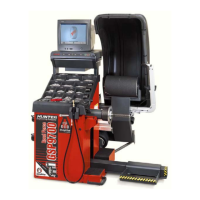64 4. Balancing a Wheel GSP9700 Series Road Force Measurement System Operation
Lay the tire down on the floor.
Remove the rim from the balancer and set it on top of the tire with the valve stem
(“VS”) mark on the tire aligned to the valve stem.
With the valve stem and valve stem (“VS”) mark aligned, transfer the road force
(“FV”) mark from the rim to the tire and label it “FV.”
Mount the tire on the rim with the road force (“FV”) mark on the tire and rim runout
(“RR”) mark on the rim aligned.
Using ForceMatch Codes Feature
When a tire or rim matching mark is placed at TDC, the corresponding ForceMatch
Code is displayed. The code numbers can be recorded on the tire/wheel for optimal
matching procedures. Matching a tire and rim with similar match code numbers may
decrease the first harmonic vibration substantially.
Matching Tire/Wheel Sets:
A set of tires and rims may be matched to each other for optimum vibration reduction.
The tire and rim with the highest match code should be paired, then tire and rim with
the second highest match code should be paired, continuing the pattern for the entire
set.
Matching Inventory:
Shops with inventory can label existing stock with ForceMatch Codes and optimally
match assemblies prior to sale to reduce ForceMatching™ mounting time, reduce tire
vibration, and increase customer satisfaction. The tire and rim match code can be
labeled and the high/low spot marked and inventoried for later use. Tires and rims
can then be matched to each other for optimal ride performance. A marginal rim or
tire can be put into stock and later be matched to a rim/tire with a similar ForceMatch
Code for a minimal first harmonic vibration.
Dial Indicator Gauges Feature
The “Show Dial Indicators” key may be selected from the “Current Runout & Road
Force” screen to display on-screen dial indicator gauges. Each gauge displays the
runout (actual arm movement) encountered at that location. This data is also
displayed as the total indicated reading (T.I.R.) data on the runout plot screens. Refer
to “Harmonics & T.I.R. Data/Plots,” page 98. If there is green only showing in the
span of the gauge, T.I.R. runout is acceptable. If green and yellow appear on the
span of the gauge, T.I.R. runout is marginal. If red appears on the span of the gauge,
T.I.R. runout has been exceeded and may prompt an informative statement to appear
in the Diagnosis Box concerning the exceeded limit. The dial indicator located directly
above the tire tread is the loaded runout of the assembly as taken by the load roller.
As the wheel assembly is rotated on the spindle, the dial indicator gauges will change
to display current information for each dial indicator gauge position.
SSEMBLY
LOADED RUNOUT
DIAL INDICATOR
LATERAL RIM RUNOUT
DIAL INDICATORS
RADIAL RIM RUNOUT
DIAL INDICATORS
“Hide Dial Indicators” can be selected to remove the dial indicator gauges from the
screen. Rim runout and road force will still be graphically depicted on the screen.

